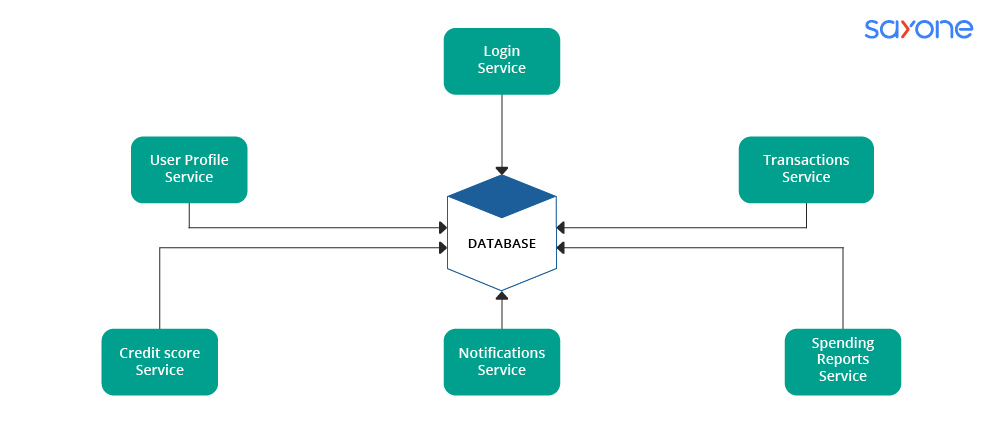Is Microservices Architecture Beneficial to Business Agility

Share This Article
Why to choose react native and how to make your react native application a success
Table of Contents
Subscribe to Our Blog
We're committed to your privacy. SayOne uses the information you provide to us to contact you about our relevant content, products, and services. check out our privacy policy.
Businesses adopt microservices architecture to bring about innovations and get them to market faster. Businesses will be able to survive intense competitive pressure only if they can bring on innovations fast. This is because of technology disruptions and evolving customer expectations.
Why Move your Business to a Microservices Architecture?
In 2020, in a survey covering 1502 respondents, a third of the respondents (29%) said their employers were implementing over half of their existing systems with microservices. These are interesting statistics.
Why is the rush to implement microservices and why are businesses betting big on them?
A business that relies on a huge monolithic business application will, at some point in time, find it difficult to deploy new services or modify the package effectively. This is what prompts businesses to move to microservices.
Microservices are essentially small and independent services that function on their own. They communicate via APIs and are loosely coupled. Each of the services is built, tested, deployed, and maintained independently without any downtime for the rest of the services. Moreover, each of the services can be written in a language that best suits the business function it is going to perform.
Having all the functions reside within a single codebase makes it difficult to bring in new innovations. Moreover, any attempt to scale the package means the entire monolithic package has to be scaled.
Microservices Alongside Monoliths – Is it Possible
Organizations need not jump headlong into microservices with a bang. They can separate functions that are complex from those that have to be scaled and turn them into microservices. This would take care of situations where specific operations are slowing down the performance of an application. For a business, this could be in areas such as stock calculation or complex pricing issues. Making this function into a microservice allows the main package to function without the demand for resources that slows it down.
This separation has provided businesses with the agility that they require. Over time, all the functions that demand a high slice of the resources can be turned into separate loosely coupled microservices, thus improving the performance to a high level.
What Kinds of Businesses Can Opt for this Shift
Retailers who have an urgent requirement for scaling a part of the application can ideally look at shifting to microservices. This is especially true for those who have to keep up with changing markets and customer expectations.
Others are organizations that do not want to be dependent on a single vendor. They may need to swap systems to face changing market needs. Ecommerce merchants are accustomed to purchasing large packages with complex features from a single vendor.
Read our blog "Business Revamp to Microservices—What are the Benefits"
Retailers who used these large packages felt secure with the all-in-one packages. Stability and simplicity come with a certain amount of dependence on the vendor. Technical debt becomes large, and there is an inability to upgrade the system according to customer demands and frequently changing market conditions.
The ideal candidates for shifting to a microservices architecture are the large, inflexible, monolithic setups that have to commit to the high-risk investment of setting up the microservices. They can choose to do this or continue to function with the high-risk monolithic system at hand, giving "business agility" a miss.
Adopting Microservices & Business Drivers
Corporations shifted to microservices because they felt comfortable doing all of their operations via a single package. Such an arrangement helps them to convey their business plan to their vendor, who would modify the package for them according to the planned business initiatives.
Today, the market functions on disruptions as massive changes to technology and customer expectations appear out of nowhere. In such situations, monolithic packages are seen to fail. Adopting microservices brings with it many advantages that help businesses tide over such situations.
With pilot programmes, assumptions can be tested and insights can be derived with equal speed. New services can be launched at will, and old and outdated ones can be withdrawn without any major modifications to the whole package.
Download our eBook for FREE “Global Software Development Rates: An Overview”.
The independent deployment factor encourages the quick release of upgrades and versions to the market, leaving customers extremely satisfied. Though different business owners will have varied appetites for risk-taking, usage of microservices helps them to apply the risk at service levels.
Allowing each business function to build and own a service also makes way for "centres of excellence" to develop and function within the organization. It is easy for such teams to set standards and develop best practices for a specific technology.
In this way, using microservices helps the business owner select the best tool for the job and not just settle for less-than-ideal ones with a compromise on performance and quality just because they are part of a large solution.
Download and read our eBook, "Choose the best microservices vendor and trim the costs"
Introducing the Microservices Architecture
One of the major advantages of the microservices architecture is that it allows businesses to reduce the scope of risk involved. A business can choose to develop a single service (business function) at a time into a microservice. This gives better control over both costs and time.
Prior to moving into microservices, you could choose a partner to help you ascribe the commercial values of the functions that you would want to transform into microservices. You can then assign priority depending on your budget. Ensure that you pick an experienced and reliable microservices vendor from the marketplace.
The monolithic system should be seen as a conglomeration of different services. Then it is easier to move each service into a separate microservice. Focusing on isolated areas to transform them into standalone services will provide the best value for your investment.
It is also important to remember that migrating to microservices will most likely place a reasonable demand on the resources that the business owner has available.The migration is a rolling and continuous project that will go on as you dismantle and recreate one service at a time.

Does Shifting into a Microservices Architecture Save Money
Microservices function to save money only if they are understood well and when best practices are continuously applied. Plunging headlong into microservices without fully understanding how they should function is a disaster in the making. In such a case, containerized microservices prove to be both wasteful and expensive.
Takeaway
If you want to derive the most advantages from microservices architecture, then it is important that your organization embraces an agile way of thinking. Adopting DevOps methods is the key. Also, include automation wherever possible. Finding the best market partner to guide you through the process of shifting to microservices is the key to improving business agility.
How can SayOne Help
At Sayone, we design and implement microservices systems that do not have complex architectural layers, and this enables the services to deliver exceptionally fast performance. Moreover, we provide services that are significantly decoupled, allowing you to launch independent services and not end up with the usual inter-dependent microservices that work more or less like a monolith.
We design the microservices keeping in mind the margin required to allow for the transition into the new system of your organization’s legacy architecture as well as expand into the cloud system. Our microservices comprise lightweight code, and we provide competitive pricing options for our clients.
Our microservices are built according to the latest international security guidelines that ensure the complete safety of all the data. We also ensure that we deliver the services within the stipulated deadlines and we always guarantee a quick turnaround time for our clients. Equipped with the best infrastructure and the latest tools and technologies, our expert developers will provide you with the best microservices that are easily scalable, enabling a good ROI in the shortest period of time.
Are you looking for a reliable partner to walk you through implementing microservices in your organization? Call us today!
Share This Article
Subscribe to Our Blog
We're committed to your privacy. SayOne uses the information you provide to us to contact you about our relevant content, products, and services. check out our privacy policy.



